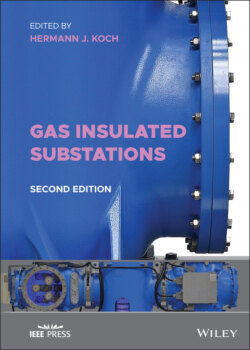Читать книгу Gas Insulated Substations - Группа авторов - Страница 2
Table of Contents
Оглавление1 Cover
7 Foreword PES Substations Committee
12 1 Introduction 1.1 General 1.2 Definitions 1.3 Standards and References 1.4 Ratings
13 2 Basic Information 2.1 History 2.2 Physics of Gas‐Insulated Switchgear 2.3 Reliability and Availability 2.4 Design 2.5 Safety 2.6 Grounding and Bonding 2.7 Factors for Choosing Gas‐Insulated Substations 2.8 Sulfur Hexafluoride (SF6) 2.9 Alternative Gasses to SF6 2.10 When to Use Gas‐Insulated Substations 2.11 Comparison High Voltage and Medium Voltage AIS, MTS and GIS
14 3 Technology 3.1 General 3.2 Modular Components, Design, and Development Process 3.3 Manufacturing 3.4 Specification Development 3.5 Instrument Transformers 3.6 Interfaces 3.7 Gas‐Insulated Surge Arresters 3.8 Gas‐Insulated Bus 3.9 Guidelines for GIS References
15 4 Control and Monitoring 4.1 General 4.2 GIS Monitoring 4.3 Local Control Cabinet 4.4 Digital Communication References
16 5 Testing 5.1 General 5.2 Type Tests 5.3 Routine Tests 5.4 Onsite Field Testing 5.5 Guidelines for Onsite Tests 5.6 Best Practice for On‐Site Field Testing References
17 6 Installation 6.1 General 6.2 Installation 6.3 Energization: Connecting to the Power Grid References
18 7 Operation and Maintenance 7.1 General 7.2 Operation of a Gas‐Insulated Substation 7.3 Maintenance 7.4 SF6 Gas Leakage Repair 7.5 Repair 7.6 Extensions 7.7 GIS Retrofit or Upgrade 7.8 Overloading and Thermal Limits 7.9 Maintenance and Operations Pointers 7.10 Lessons Learned References
19 8 Applications 8.1 General 8.2 Typical GIS Layouts 8.3 Reference Projects 8.4 GIS Case Studies 8.5 Mobile Substations 8.6 Mixed Technology Switchgear (MTS) 8.7 Future Developments 8.8 Underground Substations 8.9 Special Substation Buildings References
20 9 Advanced Technologies 9.1 General 9.2 Environment 9.3 Life Cycle Cost Analysis 9.4 Insulation Coordination Study 9.5 Very Fast Transients 9.6 Project Scope Development 9.7 Risk‐Based Asset Management of Gas‐Insulated Substations and Equipment 9.8 Health and Safety Impact 9.9 Electromagnetic Field 9.10 SF6 Decomposition Byproducts 9.11 Condition Assessment References Section 9.11 9.12 Gas‐Insulated Substations for Enhanced Resiliency References Section 9.12 9.13 Vacuum High Voltage Switching References Setion 9.13 9.14 Low Power Instrument Transformer References Section 9.14 9.15 Digital Twin of GIS and GIL References Section 9.15 9.16 Offshore GIS References Section 9.16 9.17 HVDC GIS References Section 9.17 9.18 Digital Substation References Section 9.18 References Sections 9.1 to 9.10
22 Index
